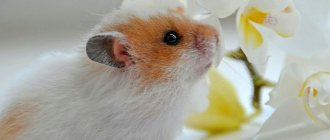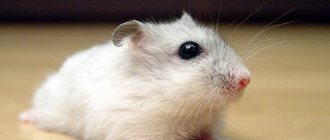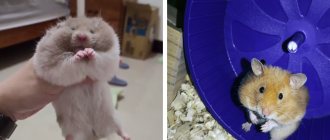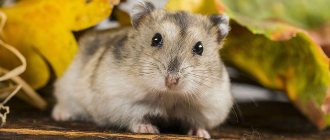- home
- General information
14.07.2018
Many people like a cute hamster with full cheeks. They are like pockets for animals to collect, briefly store and move food to a protected place. In the wild, rodents have to find their own food. For the winter, the hamster stuffs its cheeks, hibernates, periodically waking up to have a snack to saturate the body. In the summer you have to prepare a lot of food, filling your storage completely, so that you don’t have to go hungry in the winter.
The cheeks of a rodent can hold a volume of food equal to the weight of the animal. A hamster with full cheeks and pockets full will return home to fill the pantry. In order not to accidentally swallow the good he finds, he blows the grain out of his cheeks without hindrance. After emptying the pockets, the cheeks become normal size. He does this until the storage is completely filled with food. A pet can stuff its cheeks with so much food that it doesn’t fit in the pantry right away. Then it deposits part of the food on the ground, and takes the rest into the depths, after which it returns for the food left behind.
It is interesting that when collecting food of animal and plant origin, the rodent separates it: it puts grains in one pocket, and worms and grasshoppers in the other.
The purpose of cheek pouches in rodents
Wild hamsters need them to survive. The animals feed on small grains that are difficult to transport into burrows. Thanks to its huge cheeks, the rodent can make reserves. He fills the free space with food and carries it into the hole. The cheek pouches contain enough food to last the animal for a day.
Thanks to the habit of stuffing grains into its mouth, a pet can survive if it finds itself in a difficult situation. For example, when escaping from a predator, if the lair is far away.
Thanks to the supplies in the pantry, the animal easily endures hibernation. In winter, all life processes of a hamster slow down. He is in a daze and wakes up once a week to eat and relieve himself. This allows the pet to survive the cold season for which it is not adapted.
Causes of inflammatory diseases
Hamsters use their cheek muscle cavities to ensure their normal functioning. Since they can obtain food only during the warm period of the year, the animals need to take care of significant supplies for the winter in advance. For this purpose, rodents use their cheek pouches, carrying grains and seeds into their bins. Animals in natural conditions will not put any other objects into their bags. Therefore, inflammation of the cheek pouches in wild hamsters almost never develops. At home, the animal is not threatened by predators, but sometimes close contact with a person is worse than a collision with a hungry animal.
The most common causes of inflammation are:
- The presence of sticky substances and sweets in the rodent’s diet. If the bags, which contained even a small amount of food, stick together, suppuration will certainly begin. Therefore, you need to make sure that chocolate, honey, sweets and other products that are undesirable for the animal to eat do not get into the hamster’s mouth. Human treats do not bring any benefit to rodents; for them, what is tasty is grain; the desire to feed a hamster chocolate is a common manifestation of selfishness.
- Having access to sharp objects. Even sharp sawdust can cause harm if the hamster manages to stuff it into its pouch. Sharp plastic and metal are even more dangerous. The damaged surface of the muscle cavities easily becomes infected.
- Consumption of large-fraction roughage. Too large particles of food also often provoke inflammatory processes and, in advanced cases, lead to loss of bags.
Should you let your pet stuff your cheeks?
A hamster with big cheeks most often causes affection among its owners. However, in reality, this is an undesirable habit that can cause inflammation, injury and even the development of diseases.
When the tissues of the oral cavity are damaged, visual disturbances often occur in addition.
They are located close, so they also become inflamed. In the absence of timely help, the hamster may even lose sight or die.
Purpose
The cheeky hamster looks funny and amusing. Cheek pouches are like pockets for rodents; their purpose is to collect, temporarily store and transport food. In nature, wild hamsters obtain their own food. It is known that during the winter they hibernate, from which they periodically wake up to saturate their body. Over the summer, they need to fill their pantries so that there are enough supplies for the entire cold period. A hamster's cheeks can hold an amount of food equal to the animal's total weight. The hamster with his cheeks stuffed returns to his hole to leave the collected supplies in it. To do this, he blows with all his might, and the grain flies out on its own. A hamster with big cheeks becomes an ordinary animal. He performs such manipulations until his pantries are full to the top. Sometimes a hamster’s mouth can be filled with grain, peas or other foods to such an extent that it does not fit into the hole; in this case, the animal leaves some of the food on the surface of the earth, and takes the rest deeper, then returns for the rest of the goodness.
What problems may arise
The most common problems hamsters experience are:
- injuries;
- inflammation;
- infection;
- dropping out;
- food getting stuck.
Injury often occurs as a result of attempts to hide sharp objects or toys in the cheek space. A hamster may decide to stockpile not only food, but also items that are potentially dangerous to it. For example, a bolt or a piece of plastic. As a result, the mucous membranes will be damaged, which will provoke inflammation and infection.
Inflammation of the cheek pouches
A hamster that hides food behind its cheeks risks damaging its mucous membranes. If this happens, the latter become inflamed. The animal is not able to independently analyze its condition and cannot get rid of supplies in time and take a break, so it continues to injure its cheeks.
As a result, infection may occur. To prevent this, it is necessary to clean the tissues with a solution of furatsilin or chamomile decoction. This needs to be done by a veterinarian or an owner with experience, otherwise there is a risk of worsening the situation.
While stuffing the hamster's cheeks, it can damage soft tissue.
The appearance of abscesses
In the absence of timely treatment and tissue infection, an abscess occurs. The cavity fills with pus. The swelling is no longer due to food, but due to pathological contents.
The danger of the disease lies in the fact that the owner cannot detect the threat in a timely manner. The owner of the animal thinks that the hamster's cheeks are full of food.
An abscess can be distinguished from normal by elevated temperature, especially in the area of inflammation. The pet becomes lethargic, often rubs its cheeks, and spends more time in hiding.
Bags falling out
Occurs when a pet tries to place an object or large particles of food into the cavity. The disease is almost invisible visually.
The owner discovers a piece of food protruding from the rodent's mouth. Sometimes owners try to remove the problematic item themselves. This should not be done, as it can injure the hamster. Removing particles will not help straighten your cheeks.
If the bags fall out, you need to contact a veterinarian. He will clean the cavity, treat it with an antiseptic and painkillers, then set the organ back.
You cannot delay in providing assistance, as severe purulent inflammation may occur. In this case, you have to remove the bags. This does not affect the pet’s quality of life, but if the infection is severe, the rodent may die.
If your hamster's sacs fall out, you should contact your veterinarian.
Food getting stuck in bags
Owners sometimes give pets food that their pet’s body is not adapted to eat. For example, chocolate. If the hamster tries to hide it behind his cheeks, the treat will melt and remain in the cavity. It won't be possible to remove it. This will cause inflammation if the owner does not promptly clear the cavity of its contents.
The situation is worse with sharp objects. For example, small bones. The pet manages to place them in the cheek space, but he cannot get them out later. Objects scratch the mucous membranes and cause severe inflammation, which is often accompanied by infection and the development of an abscess.
When food gets stuck in the cheek pouches, an abscess can develop.
Features of behavior
The pet often amuses its owners with its stuffed cheeks. Why does a rodent fill them if there is and will be food? It's all about natural instinct. Hamsters lived longer on their own, and had to take care of their own food. They were domesticated quite recently, so they did not learn to completely suppress the instinct. No matter how much food there is in the feeder, the pet still hides food. Especially if the cage is not small with different labyrinths and rooms.
Occasionally, the pet owner will be to blame for the hamster's attempts to keep food in the house. It is necessary to ensure that there is always a sufficient amount of food in the feeder, since it is impossible to know in advance how much will be needed to satisfy hunger. If you wait a long time, as soon as food arrives in the feeder, the hamster will begin to stock up just in case.
Abscesses
Cheek pouch abscesses are common in pet hamsters. These are localized infections that cause pus to accumulate in the cheek pouch and can spread to the rest of the body quite quickly.
This is often treated by an exotic animal veterinarian with antibiotics and sometimes a good cleaning of the cheek pouch. Without treatment, the infection will become painful, causing the hamster to stop eating, and the infection may spread to the rest of the mouth and eventually into the bloodstream.
Abscesses occur for several common reasons:
- When a hamster tries to put something sharp in its mouth.
- If your hamster cuts its face on something in the cage, causing a small cut or puncture.
- When an overgrown tooth protrudes into the cheek.
British cat
The round, well-developed cheeks of a British cat are one of the main distinguishing features of the breed. It’s not surprising that every owner of a “British dog” dreams of his pet having wow cheeks! There is an opinion among people that you can “eat” your cheeks - you just need to know what, even all sorts of recipes are offered.
But the presence or absence of expressive cheeks is purely genetic, like tail length or coat texture. That’s how nature decreed it – you either have cheeks or you don’t. There are no special diets that would help enlarge the cheeks. As in the fairy tale about Cinderella: “No connections will help you make your legs small, your soul big, and your heart fair.”
Recommendations for owners
Watch which hamster hides food in its cheeks. These may be products that are not at all healthy for the animal, and sometimes even dangerous. It is interesting that individuals living in the wild are much less susceptible to such danger - their instinct of self-preservation is much higher than that of their domestic relatives. Thus, owners may unknowingly “slip” legumes or sweets or sticky foods that are unacceptable for rodents. This kind of food can cause their cheeks to stick together. And, if at this moment there is at least a little food in the bags, it will soon begin to rot and become inflamed. Therefore, if you notice bad signs, reconsider the animal’s diet.
Pay attention to the conditions in which your pet is kept: choose the filler in the cage that is intended specifically for these animals. Wood shavings, straw, plastic - all this should not be present in a fluffy's home. The pet will definitely try to make a supply for the winter from these materials.
Bubble Eye
Bubble eyes "water eyes" are one of the artificially cultivated breeds of aquarium "goldfish". He has large eyes and ocular vesicles filled with fluid. They hang down on both sides of the head, which is why many people call them cheeks. Sometimes the bubbles reach the size of up to a quarter of the fish’s body. Because of this unusual structure, the eyes often suffer, they are easily damaged, often they simply fall off, but are capable of regeneration within three to four weeks.
6 funny animals with big lips >>>
How a hamster hides food behind its cheeks
The rodent picks up food with its paws and puts it in its mouth. First, he stuffs one muscle bag, which opens from the inside and stretches under the pressure of food, then he does the same with the second. Immediately after performing these manipulations, the animal, waddling, follows to a secluded place where it leaves the food it has stored. To free the muscle cavities from supplies, the hamster presses on its chubby cheeks with its paws. As a result, the food spills out and the tissue returns to its original state. After this, the animal goes for a new portion of food.
Can a hamster live without a cheek pouch?
If your rodent’s cheek pouch still had to be removed, don’t despair. This operation will not affect his quality of life, because you make sure that he does not go hungry, constantly feed him, so that even without his food reserves in the pouches behind his cheek, he will not go to waste.
Video about hamsters and the loss of a hamster's cheek pouch
Today we talked about cheek pouches in hamsters, why similar problems can arise with them, why inflammation and abscess, prolapse occur, and how to prevent all this. We will be interested to hear your stories about rodents; share your experience of keeping hamsters on the pages of our website and VKontakte group. By the way, does your hamster have a habit of hiding supplies behind his cheek?
Features of the rodent body structure
A hamster with cheeks looks funny, but he is not always like that. They become fat when rodents hide food there; they literally swell. Hamsters are very thrifty animals, it is not difficult to see them with full cheek pouches, so the British call the animals “hamster”, which means “to store” in German.
Pets do not have to go hungry; they are given as much food as they want. But why don’t the animals stop storing food? It's all about instincts, you can't run away from them. The hamster still strives to hide some of the food, so he stuffs treats behind his cheeks. A hamster with its mouth full has long been a cartoon star; this is how it is depicted in books and magazines.
Possible problems and ways to solve them
Sometimes your hamster's big cheeks are not due to food. It may happen that your hamster's cheeks become inflamed. This disease is clogged cheek pouches. This happens because unhealthy food gets into the pet’s mouth. In the wild, a cheeky hamster with problems in the mouth is uncommon. Domesticated pets suffer from the disease much more often. You cannot put any other filler in the cage other than one specifically designed for rodents. Do not let your pet eat legumes or sweets.
Some owners do not pay attention to the recommendations and feed their hamsters liquid cereals, bones, chocolate or other sweets. Such food will cause the bags to clog. If this happens, you need to turn it out and clean it so that nothing remains. It is worse to get rid of bones because they cause inflammation of the cheeks. After cleansing, the damaged tissue must be treated with antiseptic medications. Do not feed the animal for 24 hours to allow the wounds to heal. It is not recommended to carry out the procedure yourself.
Why does a hamster stuff its cheeks?
If in its natural environment a hamster requires large supplies of food, then there is no need for a pet to do this. But he still periodically continues to hide food in his cheeks. This occurs due to the preservation of genetic information transmitted from generation to generation, even in individuals breeding in captivity. The only difference is that your pet rodent doesn't have to do this regularly. Due to changes in living conditions, the muscles of the cheek pouches atrophy over time, so indoor hamsters often suffer from an inflammatory process in the oral cavity.
Some pet hamsters do not use cheek pouches. Both young and adult individuals can do this. If the owner feeds his pet plenty and always has something to eat in his cage, then he has no need to stock up. But when an animal experiences moments of hunger, its reflex is triggered. Then he will hide a certain amount of the offered products “for a rainy day” in a secluded corner of the cage.











